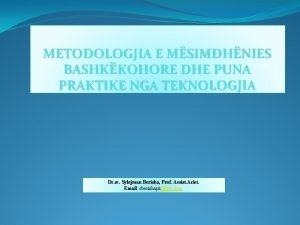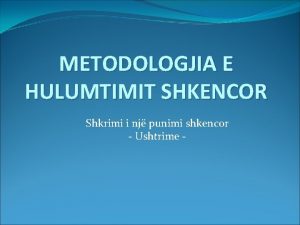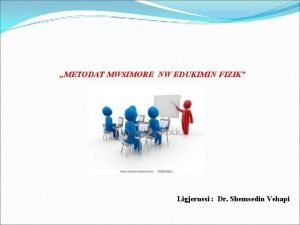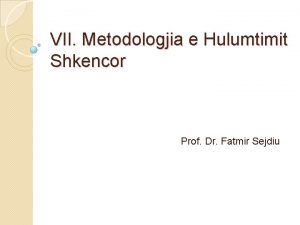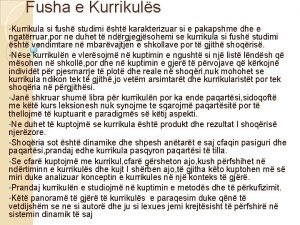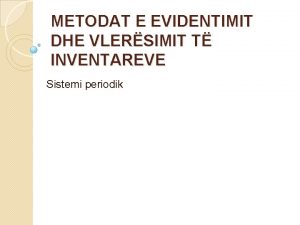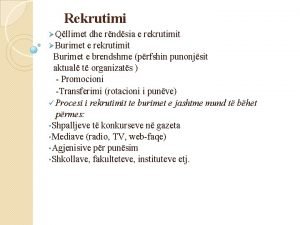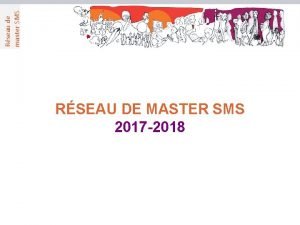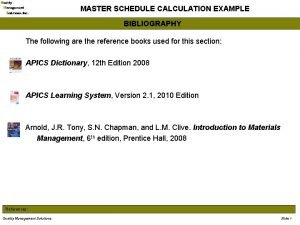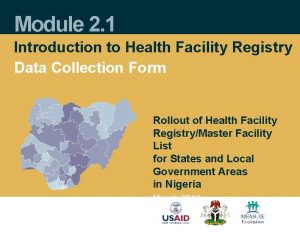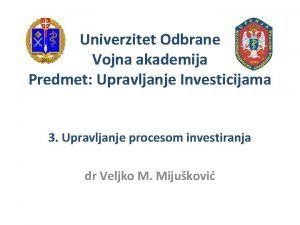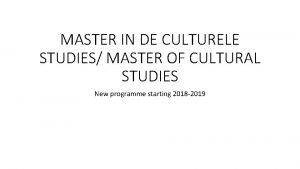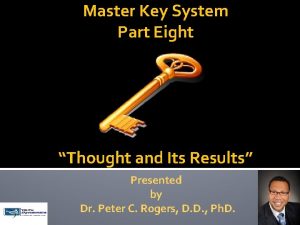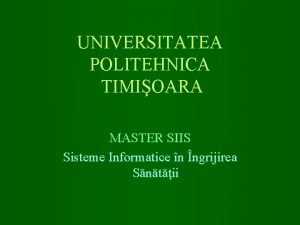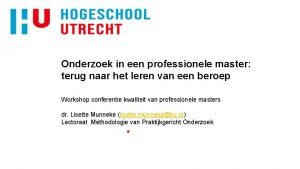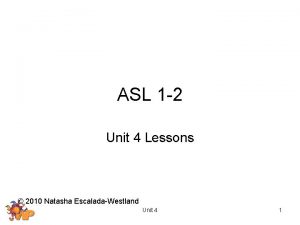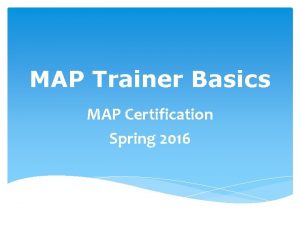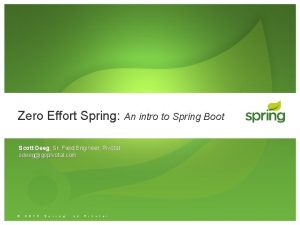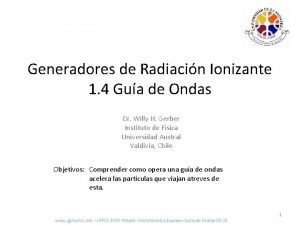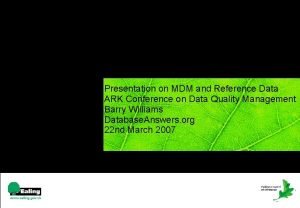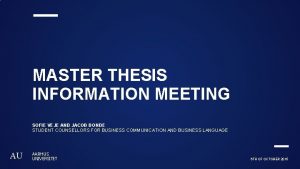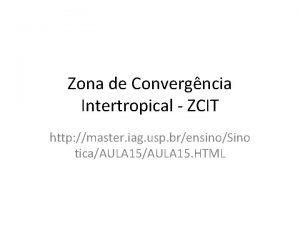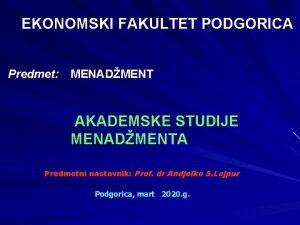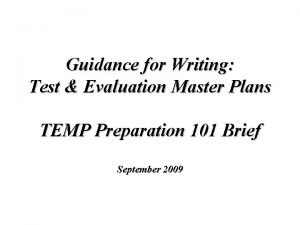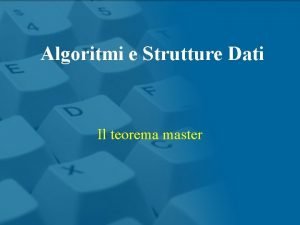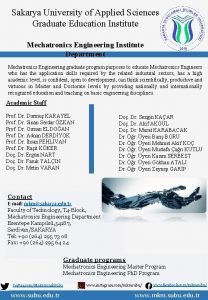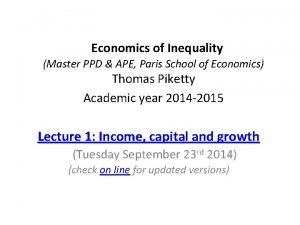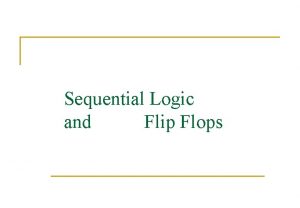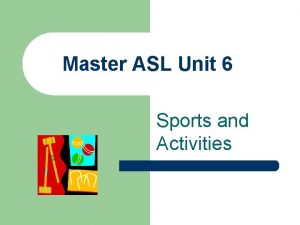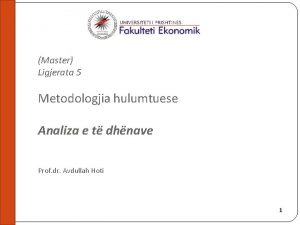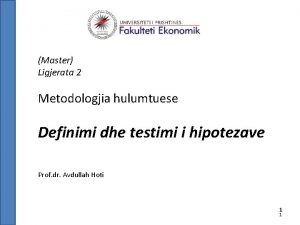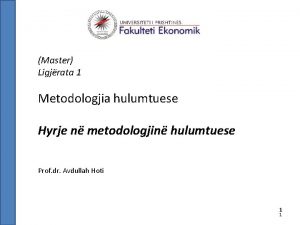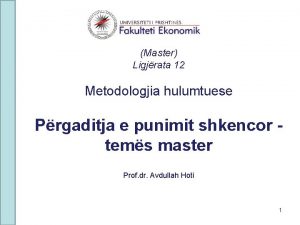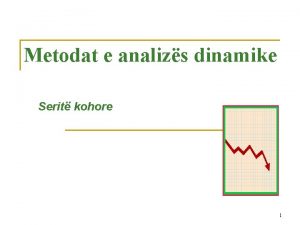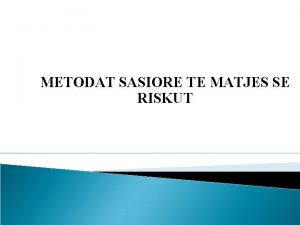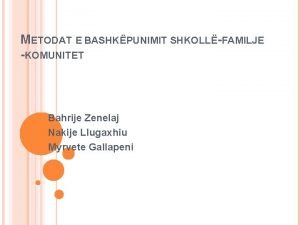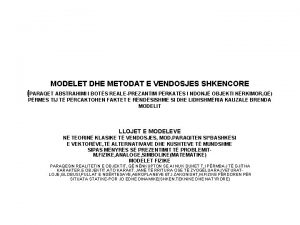Master Ligjerata 9 Metodologjia hulumtuese Metodat kuanitative n











































































- Slides: 75

(Master) Ligjerata 9 Metodologjia hulumtuese Metodat kuanitative në hulumtimet shkencore (disa modele ekonometrike) Prof. dr. Avdullah Hoti 1

Literatura 1. Gujarati, D. (2005) Essentials of Econometrics, Mc. Graw Hill Higher Education. 2. Studenmund, A. (2001): Using Econometrics: A practical Guide; Addison Wesley, Longman, Inc. 3. Verbeek, M. (2004): A guide to modern econometrics; John Wiley & Sons LTD, Chichester 4. Wooldridge, J. (2006): Introductory econometrics: A modern approach; Thompson South-Western, 3 rd edition, Mason, Ohio 2

Qëllimi i ligjëratës • Specifikat e vlerësimit kuantiativ të dukurive • Aplikimi i modeleve kuantitative në kërkime • Modelet kryesore ekonometrike në hulumtimet kuantitative – OLS – Probit • Njoftim me disa modelet të tjera ekonometrike – – Tobit model Ordered Probit Unordered Probit Interval regression models

Regresionet ekonometrike • Ekonometria - verifikim empirik i teorisë • Pse të studiojmë ekonometrinë? – Vlerësimi kuantitativ i hipotezave – Identitikimi dhe kuantifikimi i efekteve/lidhjeve në mes të dukurive – Shumë e fuqishme për predikime (inference) • Për shembull: Parashikimi i efektit të barit X në kurimin e sëmundjes Y • Ekonometria shërbehet nga: – Teoria: definimi i hipotezave – Matematika: definimi matematikor i lidhjes së variablave – Statistika: lidhjet statistikore në mes të variblave

Metodologjia ekonometrike Procedura standarde: 1. 2. 3. 4. 5. 6. 7. 8. Teoria Të dhënat Specifikimi i modelit matematik Specifikimi i modelit ekonometrik Vlerësimi i parametrave Testimi sa adekuat është modeli Testimi i hipotezave Shfrytëzimi i rezultateve

Metodologjia ekonometrike: Teoria • Formulimi i hipotezave • Shembull: – Pyetja hulumtuese: • A ndikon arsimi në nivelin e pagës? – Hipoteza: • Arsimi ndikon pozitivisht në nivelin e pagës • Diskutim për 5 minuta – Mendoni për pyetjet e juaj hulumtuese dhe ktheni ato në hipoteza 6

Metodologjia ekonometrike: Sigurimi i të dhënave • Llojet e të dhënave: – Të dhëna primare (anketat, intervistat) – Sekondare (raporte, internet, etj. ) – Të dhëna kuantitative: çmimet, të hyrat, shpenzimet, etj. – Të dhëna kualitative: gjinia, statusi martesor, shkollimi etj. – Regjistrimet (census) • Problem: Mostra adekuate – Gjithmonë sigurohuni që të dhënat vijnë nga një mostër adekuate – Cila është mostra adekuate? • Ajo mostër që më së miri i përfaqëson cilësitë dhe tiparet e popullacionit 7

Metodologjia ekonometrike: Specifikimi i modelit matematik • Paraqitja e variablave në diagrame për të zbuluar lidhjen statistikore në mes tyre – Lidhje pozitive: me rritjen e nivelit të arsimit rritet edhe paga • Parametrat: β 1 = konstantja që tregon pagën nëse personi nuk ka arsim. β 2 = pjerrësia që tregon normën e ndryshimit të pagës për njësi ndryshimi në nivelin e arsimit • Shenja e parametrave: (+) me rritjen e nivelit të arsimit rritet paga mesatare (-) me rritjen e nivelit të arsimit bie paga mesatare • Shenja e pritur derivohet nga teoria – Çfarë thotë hipoteza në rastin konkret? • (arsimi ndikon pozitivisht në pagë, prandaj shenja e pritur është pozitive) 8

Metodologjia ekonometrike: Specifikimi i modelit matematik • Konstantja: – Zakonisht nuk ka kuptim ekonomik – është një ‘grumbullues mbeturinash’ si rezultat i mospërfshirjes së faktorëve tjerë në model – Tregon mesataren e variables se varur kur faktoret e tjere kane vleren zero. 9

Metodologjia ekonometrike: Specifikimi i modelit ekonometrik • Përveç arsimit, ka edhe forca të tjera që përcaktojnë pagën • Prandaj specifikohet modeli: • ‘μ’ lejon ndikimin e faktorëve të tjerë në pagë: – përfshin të gjitha forcat e tjera që mund të ndikojnë në madhësinë e pagës, e që nuk janë përfshirë në model, – gabimet ne matje – Si dhe faktorët e tjerë që nuk mund të shpjegohen (sjellja e njeriut është jo gjithmonë e parashikuar). • Në model: – Në anën e majtë: variabla e varur – Në anën e djathtë: variablat shpjeguese (të pavarura) • Por, kjo nuk nënkupton shkakun - duhet mbështetur me teori 10

Metodologjia ekonometrike: Të dhënat 11

Metodologjia ekonometrike: Vlerësimi i parametrave (1) • Pas regresionit kemi: • Definimi i njësisë matëse të vairablave: Paga = paga mesatare e shprehur në Euro për një orë punë. Arsimi = i matur me vitet e arsimit të kryera • Interpretimi i parametrave të modelit: β 2 = 0. 55 Nëse niveli i arsimit rritet për një vit, në mesatare paga për orë rritet për 0. 55 Euro Shenja ‘+’ nënkupton efekt pozitiv të arsimit në pagë β 1 = 1. 5 Nëse punëtori është pa arsim, paga mesatare për orë pune është 1. 5 Euro. 12

Metodologjia ekonometrike: Vlerësimi i parametrave (2) Tri çështje me interes në diskutimin e parametrave: 1. Drejtimi i ndikimit të variablës së pavarur në atë të varur: – Shiko shenjën e koeficientit: pozitiv/negativ – Bazohu në teori (hipotezat e ngritura) 2. A ka ‘Arsimi’ ndikim statistikisht signifikant në ‘Pagë’? – Duhet parë ‘t-statistics’ të koeficientit të arsimit në regresion – ‘t-statistics’ = vlera e koeficientit / devijimi standard – Nëse ‘t-statistics’≥|2| atëherë ‘Arsimi’ ka ndikim signifikant në ‘Pagë’ • Në këtë rast: refuzo H 0: β 2 = 0 (Arsimi nuk ka ndikim në nivelin e pagës) 3. Madhësia e ndikimit të variablës së pavarur në atë të varur përcaktohet nga: – madhësia e koeficientit 13

Signifikanca: Ndikimi i variablave shpjeguese në variablën e varur • Hipoteza zero (null hypothesis) – hipoteza të cilën nuk e dëshiron hulumtuesi • Hipoteza alternative (alternative hypothesis) – hipoteza për vlerat e dëshiruara nga hulumtuesi • Gabimi i llojit të parë (Type I error) – refuzon hipotezën kur është e saktë • Gabimi i llojit të dytë (Type II error) – nuk refuzon hipotezën që nuk është e saktë

Gabimet statistikore Type I vs Type II erros • An inspector has to choose between certifying a building as safe or saying that the building is not safe. There are two hypotheses: – Building is safe – Building is not safe • How will you set up the hypotheses? Remember to set it up so that Type I error is more serious. H 0 : Building is not safe Ha : Building is safe

• T-statistic: nëse është ≥ 2 në vlerë absolute – refuzo Ho se parametrat βs=0 • P-values (probability values): niveli i saktë i signifikancës – tregon nivelin më të ulët të signifikancës në të cilën mund të refuzojmë Ho – për të refuzuar Ho kërkohen vlera sa më të ulta të ‘p-values’ (1, 5 dhe 10%). – Tregon fuqinë relative me të cilën mund të refuzojnë Ho • Niveli i signifikancës prej 10% nënkupton se vetëm në 10% të rasteve hipoteza zero do të ishte e vërtetë. 16

• Modelet pa konstante – Regresioni nga origjina (pa konstante) shembull: nëse të hyrat janëzero (x) atëherë tatimi në të ardhura (y) është zero. – Megjithatë rregull mos elimino konstanten edhe nëse teoria sygjeron ngase: • Mbivlerëson vlerat e parametrave të tjerë dhe i tregon signifikante edhe kurr nuk janë. • Standard errors (s. e. ): udhëzojnë se sa të sakta vlerësimet janë: me rritjen e numrit të observimeve s. e. jane më të vegjël d. m. th më preciz janë koeficientët e vlerësuar. 17

Metodologjia ekonometrike: Specifikimi i modelit • Por, sa adekuat është modeli në shpjegimin e lidhjes në mes të pagës dhe nivelit arsimor? – Ka edhe variabla tjera që ndikojnë në pagë • Kalimi prej regresionit të thjeshtë në atë të shumëfishtë. • Ky model implikon vlenë brenda parimit ‘ceteris paribus’: 1. duke mbajtur konstant nivelin e arsimit, • me rritjen e përvojës në punë për një vit, në mesatare paga për një orë pune rritet për 0. 10 njësi (Euro). 2. duke mbajtur konstant përvojën në punë • me rritjen e nivelit të arsimit për një vit, në mesatare paga për një orë pune rritet për 0. 40 njësi (Euro). 18

Metodologjia ekonometrike: Testimi i hipotezave (1) • A është i pranueshëm ky model? • A janë rezultatet në pajtueshmëri me teorinë? – Shikoni shenjën e koeficientëve • Cilin model duhet përdorur? • Të thjeshtë apo të shumfishtë? • Koeficienti i determinacionit R 2 • Sa më shumë variabla në ekuacion, koeficioni është më i lartë • Por, multikolineariteti në mes të variablave të pavarura – Shembulli i arsimit me pagën 19

Metodologjia ekonometrike: Testimi i hipotezave (2) KOEFICIENTI I DETERMINACIONIT q Tregon se sa mirë vija e regresionit i përshtatet vlerave aktuale të variablës së varur. TSS = variacioni i vlerave aktuale të Y nga mesatarja ESS = shpjeguar nga variablat shpjeguese RSS = pjesa e pashpjeguar e variacionit të vlerave të Y në vijën e regresionit TSS=ESS+RSS R 2 = ESS / TSS q R 2 merr vlera në mes 0 dhe 1 Sa më afër 1, ndryshimi në variablën e varur shpjegohet më mirë me modelin e zgjedhur q Në shembullin e pagës: R 2 = 0. 86 Spjegimi: variablat e arsimit dhe përvojës në punë shpjegojnë rreth 86% të variacionit të pagës.

Metodologjia ekonometrike: Shfrytëzimi i rezultateve • Testimi i teorisë • Parashikimi – Sa do të ishte paga mesatare për orë pune duke ditur nivelin e arsimit dhe përvojën në punë. • Propozimi i politikave/masave • Por: Cetersi paribus – Nënkupton mbajtjen fiks të faktorëve tjerë 21

Dy modele që përdoren më së shpeshti • Regresioni OLS: – metoda e katrorëve më të vegjël • Probit/Logit 22

Modeli OLS 23

OLS • OLS përdoret kur variabla e varur (Y) është: – sasiore dhe – vazhduese • Regresioni i thjeshtë (një faktorë) • Regresioni i shumëfishtë (shumë faktorë) 24

OLS: Variablat dummy (1) • Disa variabla të pavarura mund të jenë ‘Variablat dummy’ – kategorike, binare, kualitative. • Tregojnë praninë ose mospraninë e një ‘kualiteti’ • Kuantifikimi i efektit të këtyre variablave përmes krijimit të një variable ‘dummy’ që merr vlerën: 0 = mungesën e atij atributi (mashkull; papunësuar) 1= praninë e atij atributi (femër; punësuar) • Shembulli i ekuacionit të pagës: – Shtimi edhe i këtyre karakteristikave që përcaktojnë pagën: • Sektori industrial • Qyteti • Anëtarësimi në sindikatë

OLS: Variablat dummy (2) • Futja e variablave dummy në regresion - vlenë rregulli: – Nëse variabla kuantiative ka m kategori, atëherë në regresion futen m-1 kategori: • Shembull: – Gjinia: 2 kategori (mashkull/femër), në regresion futet 1 kategori – Sektorët: 3 kategori (tregti, prodhim, shërbime) në regresion 2 prej kategorive – Katëgoria që nuk hyn në regresion: kategoria bazë; referencë; kontrolluese; krahasuese.

OLS: Shembull me vairablat dummy • Vlerësimi i ‘Pagës së profesorit’ Y= paga vjetore e një profesori (në mijëra euro) Di=1 nëse profesori është mashkull Di=0 nëse është femër • Vlerësimi i ‘Shtypjes së gjakut’ Y= niveli i shtypjes së gjakut (në njësi matëse) Di=1 nëse personi konsumon produktin X Di=0 nëse personi nuk konsumon produktin X • Rezultatet (për pagën e profesorit): • • • Paga mesatare vjetore për femra është 18, 000 euro Ndërsa e meshkujve për 3, 280 euro më ë lartë = 21, 280 euro Paga mesatare për femra është më e vogël se e meshkujve. 27

Modeli Probit

Modeli Probit: Kur përdoret? • Variabla e varur si variabël dummy • Përdoret për të spjeguar probabilitetin që një ngjarje të ndodhë • Shembuj: Matja e probabilitetit për: - të qenit i punësuar për të investuar paraqitjen e fatalitetit tek personat me sëmundjen X paraqitjen e një sëmundjeje

Modeli Probit: Probabiliteti • Hudhja e parasë: probabiliteti për të rënë koka ose pjesa e pasme: – koka/totali i mundësive = 1/2 • Nëse hedhim një domino: – Mundësia për të qëlluar 1 është 1/6, për të qëlluar 2 është 1/6 e kështu me radhë • Probabiliteti është gjithmonë pozitiv dhe sillet prej 0 (nuk ka gjasë të ndodhë) deri në 1 (ngjarja ndodh me siguri të plotë)

Modeli probit: Specifikimi empirik Y = 1 nëse familja ka shtëpi private = 0 nëse familja nuk ka shtëpi private X = të ardhurat familjare (në mijëra euro) β 1 = -0. 9457 tregon ‘probabilitetin’ që familja të ketë shtëpi kur të ardhurat e saj janë zero. Pasi probabiliteti nuk mund të jetë negativ atëherë e trajtojmë këtë vlerë si zero. β 2 = 0. 1021 tregon se për njësi ndryshimi (kur të ardhurat e familjes rriten për 1, 000 euro) probabiliteti që familja të ketë shtëpi rritet për 0. 1021 ose për 10. 21%. P. sh. Familja me të ardhura mesatare prej 12, 000 (pra X=12) ka probabilitet për të pasur shtëpi prej: 31 -0. 9457+12(0. 1021)=0. 2795=28% për të pasur shtëpi

Modelet e tjera ekonometrike 32

Modelet e tjera ekonometrike: Tobit • Tobit: – Parashikimi i shpenzimeve qeveritare për ilaçe të diabetit gjatë 3 viteve të ardhshme: • Shpenzimet për ilaçe të diabetit të të gjithë personave – Së pari matet probabiliteti që personi të jetë me diabet – Pastaj, maten shpenzimet për diabet • Ky model involvon vlerësimin e dy ekuacioneve – Probabiliteti për të qenë me diabet: – Shpenzimet për diabet, kur personi është me diabet: 33

Modelet e tjera ekonometrike: Regresioni i intervaleve • Regresioni interval – Numri i vizitave tek dentisiti që bëjnë personat brenda vitit – Numri i padive nga shkelja e rregullave të trafikut • Variabla e varur merr vlera diskrete, por të kufizuara në disa alternativa 34

Modelet e tjera ekonometrike: Ordered/unordered • Regresioni ‘ordered’ (i rënditur) – ka hierarki në paraqitjen e gjendjes: • Niveli i shëndetit të personit (i dobët, i mirë, shumë i mirë) • Regresioni ‘unordered’ (jo i rënditur) – nuk ka hierarki, gjendjet janë ‘kualitativisht’ të ndryshme: • Statusi i punësimit: i punësuar, i papunë, jashtë forcës punëtore 35

Përmbledhje e ligjëratës • • Modelet kuantiative – aplikimi i ekonometrisë Modelet kryesore ekonometrike Kush e përcakton se cili model përdoret Karakteristikat kryesore të modeleve – OLS – Probit/Logit – Tobit – Interval regression – Ordered/unordered 36

Detyrë • Siguroni të dhëna për një çështje që është me interes për ju • Identifikoni modelin ekonometrik që është adekuat • Zhvilloni fazat e procesit hulumtues duke aplikuar modelin ekonometrik që keni zgjedhur • Interpretoni parametrat e modelit dhe signifikancën e modelit 37

38

Qëllimi i ligjëratës • Si aplikohen modelet ekonometrike në hulumtime empirike? • Qasja në përgatitjen e një punimi shkencor për publikim. – – – Identifikimi i qëllimeve të hulumtimit Identifikimi i hipotezave Zgjedhja e modelit ekonometrik Vlerësimi/testimi i hipotezave Interpretimi i rezultateve • Të gjitha këto do të diskutohen përmes një shembulli konkret nga një punim i botuar: – Hoti, Avdullah (2009) 'Determinants of emigration and its economic consequences: evidence from Kosova', Southeast European and Black Sea Studies, 9: 4, 435 — 458 39

Determinants of emigration and its economic consequences: evidence from Kosova 40

Context of the investigation: Why dealing with emigration and remittances? • Labour movements affects the economic prospects of countries involved, • In the origin country, emigration: – Reduces the size of the labour force, – Changes its skills composition, – Affects aggregate spending due to remittances, – Produces other second and third round effects (multiplier effects). • Around 20% of Kosova’s population is abroad • Annual remittances are estimated at 13% of GDP 41

Research questions Q 1. Given the lack of data, to provide estimates of emigrants from Kosova, their profile and brain drain, Q 2. What determines emigration decisions Q 3. Employment possibilities at home and abroad (as the driving force of emigration) Q 4. Returns to education for emigrations Q 5. Determinants of incidence and size of remittances 42

Q 1 Estimates of emigrants from Kosova and their profile • • • Emigration existed during the socialism, There is no official data after 1989, Bush (2004): 300 -500 thousand emigrants, Moalla-fetini et al. (2005): 470 thousand Riinvest (2003): 20% of households have at least one member abroad. 43

Q 1 • Profile of emigrants (based on Riinvest HLFS) – 66% males – 35% urban residents » compared to 45% of the total population – 52% age 25 -44 » compared to 29% of the total population – 61% with higher education » compared to 40% of the total population – 49% remit » Average amount remitted per month for those who remit is 347 Euro, 44

Q 1 45

Q 1 46

Q 1 Estimates of the brain drain in Kosova Proportion in the total population * Population Emigrati on rate* Number of emigrants [1] [2] [3] [4]=[2]x[3] Total population 1. 000 2, 400, 000** 0. 067 160, 800 Population of age 25+ 0. 490 1, 176, 000*** 0. 083 97, 608 Less than upper-secondary education 0. 471 553, 896 *** 0. 049 27, 141 Upper-secondary education 0. 405 476, 280 *** 0. 126 60, 011 Higher education 0. 124 145, 824 *** 0. 074 10, 791 Education level of the population aged 25+ Source of data: * Riinvest HLFS of December 2002; ** Estimated by Moalla-Fetini et al. (2005) using the size of the population from the last census of 1981 and assuming a natural growth rate of 2 percent for Albanians and 1. 2 percent for other ethnic groups living in Kosova. This estimate includes emigrants. 47 *** Own calculations by multiplying the respective proportion in the population from column 1 with the total number of population.

Q 2 What determines emigration decisions • Theory of migration: why labour moves? – Employment and wage differentials between home and abroad • The effect of: – Personal characteristics – Household characteristics – Contextual characteristics 48

Q 2 • When a person moves abroad? – Ve and Vs indicate the expected value abroad and at home respectively, – c is the costs of emigration The dep. variable is discrete, taking values of 1 if abroad and 0 if not: 49

Q 2 Data • Riinvest Household and Labour force Survey data: • 1, 252 households are interviewed with 8552 members, • In the estimation, we consider only those of age 16 -64: • 4, 891 observations • Of whom, 431 or 8. 8% are abroad 50

Q 2 Defining the explanatory variables Explanatory variables Definition Personal characteristics Age of the person Education Dummies: less than upper-secondary (the omitted), upper-secondary and higher Marital status Dummy=1 if married, 0 otherwise Household characteristics Household size Number of household members Household incomes €/month per capita without including remittances Household incomes squared €/month per capita without including remittances squared Contextual characteristics Residence Dummy=1 if the person is from urban areas, 0 if from rural areas Regional dummies Dummies for the 7 main regions (omitted dummy for the Prishtina region) 51

Q 2 Findings 52

Q 3 Marginal effects 53

Q 3 Q 3. Employment possibilities at home and abroad as the driving force of emigration • 61% of emigrants aged 16 -64 are employed as compared to 30% of non-migrants, • We investigate the change in the probability of being employed when a person emigrates, • A probit model is estimated: the dependent variable equals 1 if the person is employed in Kosova (in the case of non-migrants) or abroad (in the case of emigrants) and 0 if not. • We use the sample as in the previous estimations. 54

Q 3 Definition of variables • Education dummies that proxy for the potential wage. • Age and age squared account for work experience and also the changing attitudes toward work with age. • Marital status (dummy that equals 1 if married) controls for the effect of family obligations as well as culture, attitudes and family arrangements regarding employment. • Residence: dummy=1 if abroad 55

Q 3 Findings 56

Q 3 Marginal effects 57

Q 4 4. Returns to education for emigrations • Wage differentials due to education among emigrants utilising the Mincerian wage equation • The basic Mincerian wage equation (Mincer, 1974) relates the log wage (ln wi) to years of education (Edi) and experience (Expi) and its square (Expi 2): • Findings indicate if education obtained in Kosova is rewarded in the foreign market. • The sample consists of employed emigrants aged 16 -64 with non-missing data on monthly wages as reported by the household head in Kosova. 58

Q 4 • The explanatory variable: – for human capital: education dummies, – work experience: • age and age squared • years of emigration – marital status (a dummy that equals 1 if married) – gender – the country of emigration • We do not have sufficient observations to estimate separate regressions by gender. We only allow for differences in the intercept. 59

Q 4 Findings 60

Q 5 Q 5. Determinants of incidence and size of remittances • The orthodox theory fails to explain what determines a migrant’s remittances, because it assumes that migration is an individual strategy to maximise income, in which case one would expect to observe zero remittances. • The new economics of migration brings a household perspective to migration decisions, where emigration is a household strategy for allocating labour so as to increase household incomes and reduce the risk 61

Q 5 Motivation for remitting • The motivations for migrant’s remittances are thought to be similar to motivations for other intra-household transfers. • First, migrants may remit induced by altruistic behaviour, where remittances increase with migrant’s incomes and the degree of altruism and decrease with household incomes. • Second, remittances can also reflect migrants’ desires to diversify their portfolios (Bouhga-Hagbe, 2006). • Third, remittances may be viewed as repayments of loans used to finance migration costs and/or migrant’s human capital. • Finally, migrants may remit to ensure that in the future they will be given rights towards their household’s wealth. 62

Q 5 Methodology • We follow the model provided by Funkhouser (1995), where emigrant’s utility function includes the utility of the household left behind: • Where: – Um is the emigrant’s own utility and – Uh is the household utility in the source country (each are dependent on consumption Cm and Ch respectively). • The importance of the utility of the household left behind in the migrant’s own utility U depends on the relationship of the migrant to the household captured by the vector Z. 63

Q 5 We investigate: (i) the probability that an emigrant remits – where yi denotes the observed amount of remittances sent home (in €/month) by the emigrant i. – We estimate a probit model: 64

Q 5 • (ii) determinants of the size of remittances – 49% of emigrants aged 16+ remit (i. e. yi>0). – For the rest with yi=0 (corner solution), the dependent variable is a continuous variable, but truncated at zero. – The Tobit model handles the situations when y is characterised by the corner solution – Where • yi* is the latent variable and yi is its observed counterpart, • xi is a vector of explanatory variables expected to affect yi*, • is the vector of parameters to be estimated 65

Q 5 • The Tobit model involves estimating • The direction (i. e. the sign) of the effect of explanatory variables xi on yi is the same with regard to Pr(yi>0 | xi) and E(yi | yi>0, xi, ). • The marginal effect can be split into two parts. – First, if yi=0, as xi increases then the probability that yi>0 increases. – Second, if yi>0 as xi increases then the mean response of yi increases. 66

Q 5 Defining the explanatory variables 67

Q 5 Findings: the probability of remitting 68

Q 5 Marginal effects • For a representative male who is: – – – – 31 years old, with higher education, married, employed, from urban areas, from a household with 10 members, with household incomes per capita without including remittances at the sample average (€ 37 per month) and – who has 8 years of emigration, the probability of remitting is 0. 72. • For a similar female, this probability is 0. 36. • Doubling the household incomes decreases the probability of remitting by 5 percentage points for males and by 4 percentage points for females. • Increasing the years in emigration by one year ceteris paribus, increases the probability of remitting by 1 percentage point for males and by 2 percentage points 69 for females.

Q 5 Findings: The size of remittances (the Tobit model) 70

Q 5 Marginal effects (conditional and unconditional) • For all emigrants, males remit 42 percent more than females (column 3), – Of those who remit, males remit 32 percent more than females (column 4). • Those who are employed remit 165 percent more than those who are not employed. – Of the emigrants who remit, the employed remit 138 percent more than those who are not employed. • For all emigrants, a 1 percent increase in household incomes is associated with a decrease in remittances by 0. 137 percent ceteris paribus. – Of the emigrants who remit, as the household incomes increase by 1 percent the amount remitted decreases by 0. 099 percent • Finally, for all emigrants an additional year of emigration increases remittances by 3. 7 percent, – of emigrants who remit the amount remitted increases by 2. 7 percent. 71

Conclusions (1) 1. We provided evidence on emigration and remittances in Kosova 2. The likelihood of emigration decreases with age and increases with education and household size. 3. Some indirect evidence for the positive effect of emigration networks. 4. Emigration decisions are expected to be driven by the perceived higher chances of employment upon emigration. 72

Conclusions (2) 5. No evidence that education (and experience) obtained in Kosova is rewarded in the foreign labour market. 6. Emigrants who are employed are more likely to remit than the non-employed emigrants. 7. The incidence of remitting and the amount remitted decrease with the household income in Kosova and increase with years of emigration. 73

Conclusions (3) • These findings can be used to provide a better estimation (and forecast) of remittances. This may contribute to better estimation of the consumption and savings by households and therefore improve the national accounts estimates in Kosova. 74

Thank you! 75
 Metodat hulumtuese
Metodat hulumtuese Anketa shembuj
Anketa shembuj Kuantitative
Kuantitative Metodologjia
Metodologjia Gerzheta perralle
Gerzheta perralle Te nxenit aktiv
Te nxenit aktiv Metoda me ne qender nxenesin
Metoda me ne qender nxenesin Konkluzioni i nje punimi
Konkluzioni i nje punimi Shemsedin vehapi
Shemsedin vehapi Metodologjia e hulumtimit
Metodologjia e hulumtimit Metodologjia shembull
Metodologjia shembull Analiza empirike
Analiza empirike Kurrikula shkollore dhe metoda humaniste
Kurrikula shkollore dhe metoda humaniste Metoda e kostos mesatare
Metoda e kostos mesatare Hulumtimet sasiore
Hulumtimet sasiore Metodat e rekrutimit
Metodat e rekrutimit Master sms
Master sms Master asl unit 5
Master asl unit 5 Shadow master in gfs
Shadow master in gfs Master production schedule calculation
Master production schedule calculation Master facility registry
Master facility registry Vojna akademija master
Vojna akademija master Gys vision gurgaon
Gys vision gurgaon Mira gorris
Mira gorris Unit 3 story comprehension asl
Unit 3 story comprehension asl Master culturele studies
Master culturele studies Is the master key system evil
Is the master key system evil Master trainer 45
Master trainer 45 Segregarea caracterelor
Segregarea caracterelor Master quess
Master quess Professionele master
Professionele master West kowloon cultural district master plan
West kowloon cultural district master plan Unit 4 comprehension test asl
Unit 4 comprehension test asl Webetest
Webetest Master business administration tor vergata
Master business administration tor vergata Utwente lisa
Utwente lisa Jeffrey wang dax
Jeffrey wang dax Spring security zero to master download
Spring security zero to master download Masterwall recote
Masterwall recote Pima master gardeners
Pima master gardeners Hms profibus master simulator
Hms profibus master simulator Master title style
Master title style Outgoing invoice
Outgoing invoice Master fisica medica uv
Master fisica medica uv Esp dakar formation payante
Esp dakar formation payante Master data management slides
Master data management slides Master title style
Master title style Crucial conversations path to action
Crucial conversations path to action Master thesis au
Master thesis au Master-/instanzenkonzept
Master-/instanzenkonzept Fu berlin informatik master
Fu berlin informatik master Master procurement plan
Master procurement plan Solving recurrences substitution method
Solving recurrences substitution method Ika master plant
Ika master plant A day in the life of a scrum master
A day in the life of a scrum master Zcit
Zcit Forest wide roles
Forest wide roles Master theorem exercises
Master theorem exercises Master shot film
Master shot film Validation report
Validation report Ekonomski fakultet podgorica master studije
Ekonomski fakultet podgorica master studije Test evaluation master plan
Test evaluation master plan Rit fsae
Rit fsae Virginia master gardener volunteer management system
Virginia master gardener volunteer management system Teorema master
Teorema master Santa maria veronica
Santa maria veronica Master procurement plan
Master procurement plan Sakarya university of applied sciences
Sakarya university of applied sciences Master ppd
Master ppd Vu computer science master
Vu computer science master Oracle master data
Oracle master data What is flip flop
What is flip flop Diane loth
Diane loth Master asl unit 6
Master asl unit 6 Wbs numbering
Wbs numbering Agenda master page
Agenda master page





